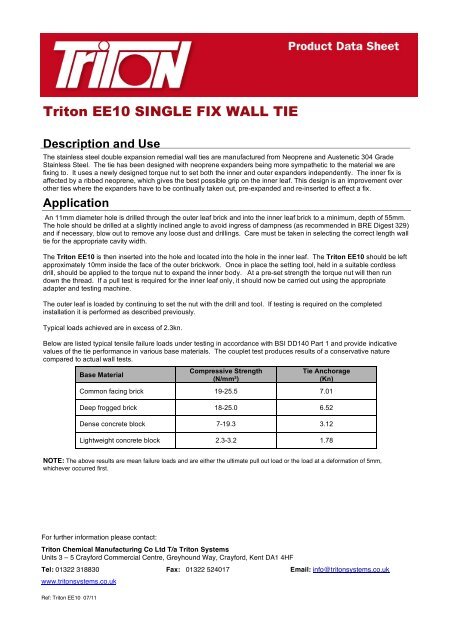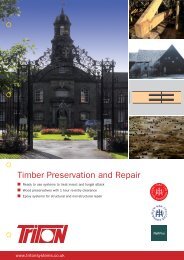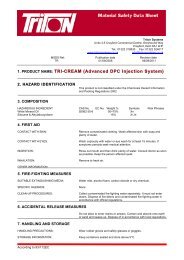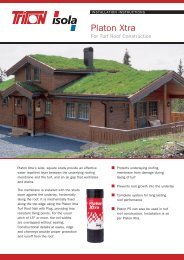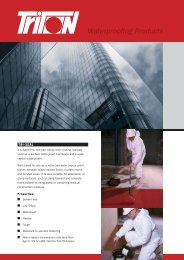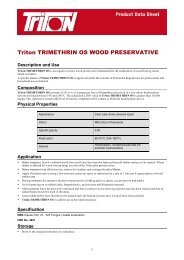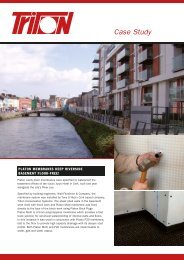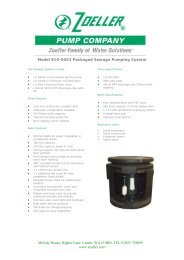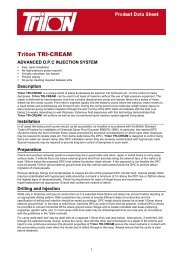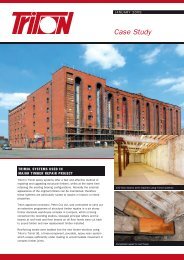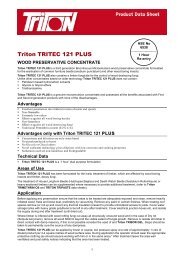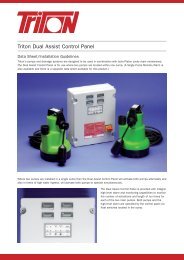Structural Repair Data Pack Download - Triton Chemicals
Structural Repair Data Pack Download - Triton Chemicals
Structural Repair Data Pack Download - Triton Chemicals
You also want an ePaper? Increase the reach of your titles
YUMPU automatically turns print PDFs into web optimized ePapers that Google loves.
<strong>Triton</strong> EE10 SINGLE FIX WALL TIEDescription and UseThe stainless steel double expansion remedial wall ties are manufactured from Neoprene and Austenetic 304 GradeStainless Steel. The tie has been designed with neoprene expanders being more sympathetic to the material we arefixing to. It uses a newly designed torque nut to set both the inner and outer expanders independently. The inner fix isaffected by a ribbed neoprene, which gives the best possible grip on the inner leaf. This design is an improvement overother ties where the expanders have to be continually taken out, pre-expanded and re-inserted to effect a fix.ApplicationAn 11mm diameter hole is drilled through the outer leaf brick and into the inner leaf brick to a minimum, depth of 55mm.The hole should be drilled at a slightly inclined angle to avoid ingress of dampness (as recommended in BRE Digest 329)and if necessary, blow out to remove any loose dust and drillings. Care must be taken in selecting the correct length walltie for the appropriate cavity width.The <strong>Triton</strong> EE10 is then inserted into the hole and located into the hole in the inner leaf. The <strong>Triton</strong> EE10 should be leftapproximately 10mm inside the face of the outer brickwork. Once in place the setting tool, held in a suitable cordlessdrill, should be applied to the torque nut to expand the inner body. At a pre-set strength the torque nut will then rundown the thread. If a pull test is required for the inner leaf only, it should now be carried out using the appropriateadapter and testing machine.The outer leaf is loaded by continuing to set the nut with the drill and tool. If testing is required on the completedinstallation it is performed as described previously.Typical loads achieved are in excess of 2.3kn.Below are listed typical tensile failure loads under testing in accordance with BSI DD140 Part 1 and provide indicativevalues of the tie performance in various base materials. The couplet test produces results of a conservative naturecompared to actual wall tests.Base MaterialCompressive Strength(N/mm²)Tie Anchorage(Kn)Common facing brick 19-25.5 7.01Deep frogged brick 18-25.0 6.52Dense concrete block 7-19.3 3.12Lightweight concrete block 2.3-3.2 1.78NOTE: The above results are mean failure loads and are either the ultimate pull out load or the load at a deformation of 5mm,whichever occurred first.For further information please contact:<strong>Triton</strong> Chemical Manufacturing Co Ltd T/a <strong>Triton</strong> SystemsUnits 3 – 5 Crayford Commercial Centre, Greyhound Way, Crayford, Kent DA1 4HFTel: 01322 318830 Fax: 01322 524017 Email: info@tritonsystems.co.ukwww.tritonsystems.co.ukRef: <strong>Triton</strong> EE10 07/11


